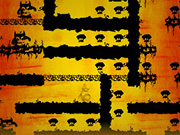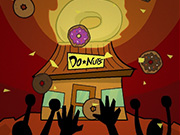
Tiled Map Editor Screenshot
I was looking into XML Tile Map editors a while ago and I found Tiled Map Editor. The site looked nice and was recently updated so I thought it looked like a good one to try. I recognized the demo maps displayed in the editor screenshots, they were from The Mana World. I contributed a few tiles to the project back in 2004, about midway through my journey through college.
During that time I was trying to figure out how I was going to be able to make games for a living. Although I was developing games like Thugjacker in my free time, I never believed there was a career in doing Flash games. I was preparing to become a 3D environmental artist, hoping to break into the game industry by designing a Half-Life 2 map. But I’ve always had the urge to explore different 2D art styles — I had a huge fascination with pixel art. During that time I would browse the Pixelation forum. The pixel art there was inspiring and I wanted to get in on it, but it was kind of hard with no direction. I just wanted to make some assets and learn the craft, not do all the characters and everything else. Shortly after that, I found a post recruiting people for The Mana World.
The Mana World is a free and open-source 2d MMORPG. It runs on the eAthena server, which is open-source software that emulates a Ragnarok Online server. I thought the game looked cool. It looked like Secret of Mana which was one of my favorite games growing up. It also reminded me of Ragnarok Online, which I didn’t play much but thought was super cool (I loved the art). So I jumped in.
Back when I first saw it, the game was super rough. Laggy. Buggy. But I loved being a part of it, the team was dedicated. It was exciting to log in everyday and see what changes were made while I was away. Most of the game development discussion was done in IRC chat rooms. There were many contributors. And good number of enthusiasts as well, which mostly played and gave feedback.

These are the tiles that I contributed to The Mana World.
I ended up dropping out of the project shortly after finishing these tiles. I had to devote more time to finishing school and my own projects. Looking back, it was my first experience working in a game development team that wasn’t just me and Ricky. I got some practice with working remotely with a team that was based in Europe. I got to feel the pressure of having to deliver game assets and the joy when everyone enjoyed what I contributed. It was also my first exposure to the concept of SVN — which saved me from feeling dumb when I first started using SVN at work.
I think it’s important to remember there’s always a game team out there that could use some help. People in school or just trying to break in the industry can look for these opportunities to gain some experience, and hopefully that leads to more confidence and some good portfolio pieces. From my experience on this project I knew that I could handle tiled pixel artwork. I wouldn’t revive this ability until 2007 on LUV Tank.
Peace!
-Bryson













 My co-worker then went to go on about strategy games like
My co-worker then went to go on about strategy games like 